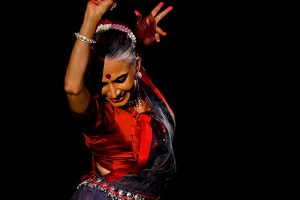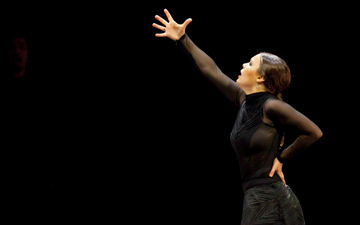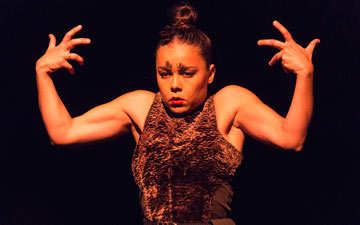
© Anna Lee Campbell. (Click image for larger version)
Rocio Molina
Afectos
Part of Flamenco Festival USA 2014
New York, Baryshnikov Arts Center
21 March 2014
www.rociomolina.net
www.bacnyc.org
www.flamencofestival.org
Marina Harss overview of the Festival in NY Times
Free to Be
If there’s one overriding impression left by Rocío Molina’s intimate evening Afectos it’s the general eschewing of flamenco clichés. Molina does what she likes and is indebted to no-one. Compact, unpredictable and elfin, she seems to dance for her own pleasure and that of her collaborators, the singer Rosario “La Tremendita” and double-bassist Pablo Martín. They in turn seem fascinated by her. Afectos is a trio that feels like a three-way conversation, with Molina as its most volatile, eccentric participant, basking in the protective embrace of two indulgent co-conspirators. (Pablo Martín, on double-bass, watches her with benevolent amazement; the relationship with Rosario “La Tremendita” is more complex.)

© Anna Lee Campbell. (Click image for larger version)
On paper, the evening is divided into five sections – Íntimo, En Ti Mi Pulso, Sal y Ponte Dama Hermosa, Café con Ron, and Afectos – but the effect is more fluid, with each new song introducing a shift in mood. The set is simple: an armchair to the left, a rocking chair and clothes tree (for costume changes) in the back, and the double bass on the right. Molina treats the stage like a private, almost domestic space, changing her top layer of clothes several times over the course of the show, or sitting on the rocking chair to listen to La Tremendita sing in her throbbing, hoarse voice. She wears none of the traditional flamenco garb, replacing it with a whimsical bohemian look: loose tunics, beautiful red shoes, a floor-length cloak that billows as she moves, and finally, a black body-stocking that reveals every detail of her pliant technique. La Tremendita, in turn, melds the intensity of flamenco with the quieter, more confessional style of chanson. Unlike most cantaores, she doesn’t really project but rather brings the audience in, turning the almost epic prehistoric themes of cante into her own private dramas.
For a long time Molina listens; she cradles a guitar, twists her body around it as if to conjure its sound. Then, on a whim, she gets up and begins to dance. The first thing one is taken by is the soft curves of her compact frame, the pliancy of her spine, shoulder, and hip. She dances with a fluency that belies her conservatory training – she is a graduate of the Royal Conservatory of Dance in Madrid – which allows her to combine the techniques of flamenco with the fluidity of modern dance to create her own idiom. Rather than water things down, she personalizes them, combining complex and excitingly subtle footwork with rolling hips and shoulders, sudden and searing quebrada turns with quicksilver movements of her arms and hands that seem to paint the air around her. Often, as she dances, she clicks her tongue. Contrasting moods and ideas wash over her face: an ugly scowl, or a look of surprise that makes her eyes gleam, or a crocodile-like smile. She’s an impish performer. At one point, before walking off, she strides over to the double bass and strums a chord, like an impudent child.

© Anna Lee Campbell. (Click image for larger version)
Much of Afectos seems to center on Molina’s relationship with La Tremendita – the two have worked together for years. Molina addresses many of her dances to the singer, as if seeking her approval and protection. Halfway through, she sits on a stool with La Tremendita behind her, almost concealed within her embrace. As both women clap out rhythms, they become almost one being, with Molina’s rapping feet at the base and La Tremendita’s expressive face at the summit. Throughout the show, they tell secrets, whisper in each other’s ears. At the beginning of the nursery-rhyme-like “Chiribi Chiribi,” they share a private joke. “En el baile, nadie me gana,” Molina quips, cheekily, (“in dancing, no-one is better than me”), to which La Tremendita replies, “y en el cante, nadie me gana.” They’re two of a kind. In “Café con Ron,” a playful, sensual guajira, Molina joins in the music-making, and also offers her own body – her belly, her shoulder – as a sounding board for the singer, who raps out rhythms on her skin.
In fact, at times the circle formed by the two women can feel too closed, too self-referential. The atmosphere of mutual discovery wears thin at times; at 85 minutes with no intermission, the show is a good ten minutes too long, and by the end, at the Baryshnikov Arts Center, there was a slow drip of defections. Because of its episodic structure, the energy ebbs and flows too nonchalantly, without the euphoric highs of flamenco. Molina’s dance interludes begin to blend together, more in mood than in execution. And the beginning and ending of the evening are somewhat precious, with Molina mostly listening and emoting. At the end, as La Tremendita croons “no puedo ser feliz” (I can’t be happy), Molina sits, staring out with a melancholy moue, digging her hands under her arms or flickering her fingers like spiders. The energy generated in the previous section dissipates. It is the one clichéd moment of the show, and it’s a shame, because Molina is a curious and fascinating performer, one I would gladly see again.

















You must be logged in to post a comment.